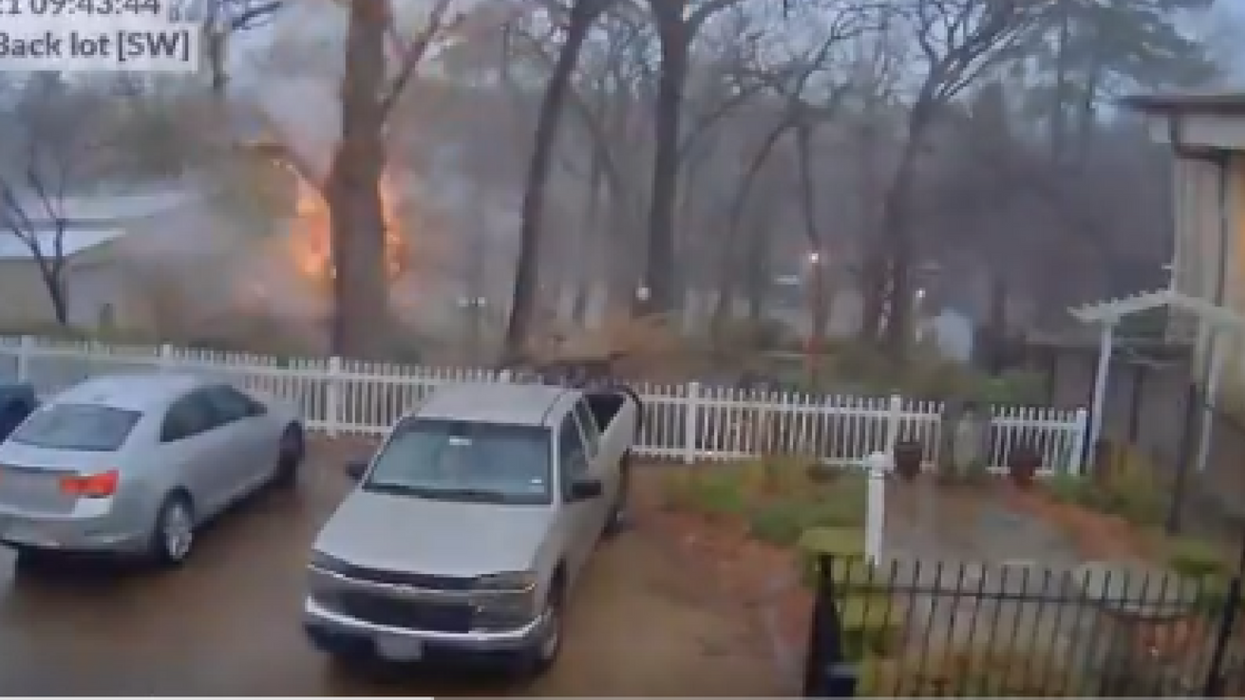A remarkable video perfectly demonstrates why the age-old adage is true—that standing under a tree when lightning is present is really, really dangerous.
In a tweet posted by the National Weather Service on Wednesday, lightning can be seen striking a tree at Bishop Thomas K. Gorman Catholic School in 2016, causing the tree to literally explode.
Giphy
In their tweet, the NWS reiterated safety measures, which most people would assume are common knowledge, that should be executed when in the presence of lightning.
" During a thunderstorm - standing under a tree is literally the WORST place to be.
During a thunderstorm - standing under a tree is literally the WORST place to be.
 During a thunderstorm - even sitting in a parked car under a tree is dangerous due to falling limbs from lightning and wind.
During a thunderstorm - even sitting in a parked car under a tree is dangerous due to falling limbs from lightning and wind.
 Imagine how many people don't know this?"
Imagine how many people don't know this?"
"While we don't like to see any lightning deaths, the continuing downward trend in yearly fatalities is encouraging," meteorologist John Jensenius told USA Today. In 2001, the National Weather Service launched its "when thunder roars, go indoors" campaign in an attempt to educate the public about the dangers of lightning. It has been enormously successful, reducing the number of annual deaths from lightning from 55 in 2001 to 17 in 2017.
Of course, trees aren't the only hazards to avoid if you're caught outside during a thunderstorm. "Stay away from trees, power poles, antennae and away from lakes, ponds and water," the NWS said. "Stay away from metal objects such as fences, railroad tracks and metal bleachers."
Also, if you're playing golf and you hear thunder, don't swing your clubs
Accuweather has additional tips for those caught outside in thunderstorms here.
Remarkably, people on Twitter had no idea that tall and/or metal objects should be avoided during thunderstorms. Lightening bolts can carry millions of volts of electricity in a single strike. In fact, a study published in Science in 2016 showed just how much energy can be locked up in a single lightning strike. Using fossils, scientists were able to determine that not only can temperatures reach upwards of 20,000 degrees Celsius, but the energy released in a single strike can be measured in terawatts.
"So based on our calculations, how close does Hollywood come, with estimates like in Back to the Future of 1.21 gigawatts of power in lightning?
Power is energy per time, and our measurements of fulgurites suggest that megajoules of energy make rock in thousandths to millionths of seconds. So a gigawatt is actually on the low side – lightning power may be a thousand times that, reaching into the terawatts, though the average is probably tens of gigawatts.
That's enough energy to power about a billion houses, albeit only for a few millionths of a second. Unfortunately, given its sporadic and unpredictable nature, no power grid will ever be able to harness lightning effectively."
Yeah, really.

















 breast cancer GIF by Baptist Health South Florida
breast cancer GIF by Baptist Health South Florida  Teddy Bear Doctor GIF
Teddy Bear Doctor GIF  feeling neck skin GIF
feeling neck skin GIF  praying GIF
praying GIF 
 Snail Ugh GIF by Sticker Book iOS GIFs
Snail Ugh GIF by Sticker Book iOS GIFs  Serious
Serious  Home Alone Reaction GIF by 20th Century Fox Home Entertainment
Home Alone Reaction GIF by 20th Century Fox Home Entertainment  Cat Working GIF
Cat Working GIF